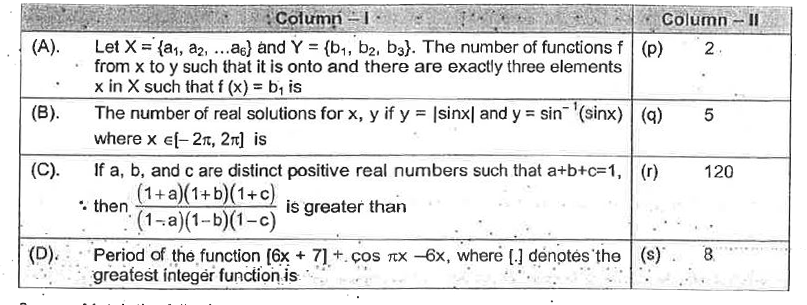Let f be a real valued periodic function defined for all real umbers x such that for some fixed a>0 , f(x+a)=12+√f(x)−{f(x)}2 for all x .
Then , the period of f(x) is
range of f{x} is [12,1]
f(x) is many-one
f(x) is periodic
f(x) is odd
The correct Answer is:A, B, C
Step by step video, text & image solution for Let f be a real valued periodic function defined for all real umbers x such that for some fixed a gt 0 , f(x+a)=(1)/(2)+sqrt(f(x)-{f(x)}^(2)) for all x . Then , the period of f(x) is by Maths experts to help you in doubts & scoring excellent marks in Class 12 exams.
Updated on:21/07/2023Topper's Solved these Questions
- FUNCTIONBOOK - FIITJEECHAPTER - FUNCTIONEXERCISE - COMPREHENSIONS
8 Videos
- FUNCTIONBOOK - FIITJEECHAPTER - FUNCTIONEXERCISE - MATCH THE COLUMNS
6 Videos
- FUNCTIONBOOK - FIITJEECHAPTER - FUNCTIONEXERCISE - ASSIGNMENT PROBLEMS (OBJECTIVE) Level-I
47 Videos
- ELLIPSEBOOK - FIITJEECHAPTER - ELLIPSEEXERCISE - NUMERICAL BASED
4 Videos
- HEIGHTS & DISTANCE BOOK - FIITJEECHAPTER - HEIGHTS & DISTANCE EXERCISE - ASSIGNMENT PROBLEMS (OBJECTIVE) LEVEL-II
20 Videos
Similar Questions
A functional equation is an equation, which relates the values assumed by a function at two or more points, which are themselves related in a particular manner. For example, we define an odd function by the relation f(−x)=−f(x) for all x.This defination can be paraphrased to say that it is a function f(x), which satisfies the functional relation f(x) + f(y) = 0, whenever x+y = 0. Of course this does not identify the function uniquely, sometimes with some additionl information, a function satisfying a given functional equation can be identified uniquely.
Suppose a functional equation has a relation between f(x) and f(1x), then due to the reason that reciprocal of a reciprocal gives back the original number, we can substitute 1x for x. This will result into another equation and solving these two, we can find f(x) uniquely. Similarly, we can solve an equation which contains f(x) and f(-x). Such equations are of repetitive nature .
Suppose that for every x≠0 af(x)+bf(1x)=1x−5, where a≠b then the value of the integral ∫21f(x)dx is
View SolutionMatch the following:

View SolutionIf f(x)=√4−x2+1√|sinx|−sinx, then the-domain of f(x) is
View SolutionS and Tare the foci of the ellipse x2a2+y2b2=1 and B is an end of the minor axis. If STB is an equilateral triangle, the eccentricity of the ellipse is e then find value of 4e
View SolutionThe height of a house subtends a right angle at the opposite street light. The angle of elevation of light from the base of the house is 60∘. If the width of the road be 6 meters, then the height of the house is
View SolutionLet f be a real valued function such that f(x)+3xf(1x)=2(x+1) for all real x>0. The value of f(5) is
View SolutionLet f(x) be periodic and k be a positive real number such that f(x+k)+f(x)=0 for all x in R. Then the period of f(x) is
View SolutionIf f(x)in[1,2] where x in R and for a fixed positive real number pf(x+p)=1+sqrt(2f(x)-{f(x)}^(2)) for all x in R then prove that f(x) is a periodic function
View SolutionIf f(a−x)=f(a+x) and f(b−x)=f(b+x) for all real x, where a,b(a>b>0) are constants, then prove that f(x) is a periodic function.
View SolutionIf f is a function of real variable x satisfying f(x+4)−f(x+2)+f(x)=0 , then f is periodic function with period:
View SolutionLet f be a real valued periodic function defined for all real umbers x such that for some fixed a>0 , f(x+a)=12+√f(x)−{f(x)}2 for all x .
Then , the period of f(x) is
View SolutionLet f(x) be a real valued function such that f(0)=12 and f(x+y)=f(x)f(a-y)+f(y)f(a-x),∀x,y∈R, then for some real a,
View SolutionConsider function f satisfying f(x+4)+f(x−4)=f(x) for all real x .Then f(x) is periodic with period
View SolutionIf f(a−x)=f(a+x) and f(b−x)=f(b+x) for all real x, where a,b(a>b>0) are constants, then prove that f(x) is a periodic function.
View SolutionIf f(a−x)=f(a+x) and f(b−x)=f(b+x) for all real x, where a,b(a>b>0) are constants, then prove that f(x) is a periodic function.
View SolutionLet 'f' be a real valued function defined for all x∈R such that for some fixed a>0,f(x+a)=12+√f(x)−(f(x))2 for all 'x' then the period of f(x) is
View Solution

